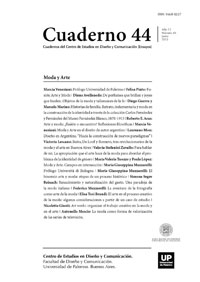Renacimiento y naturalización del gusto. Una paradoja de la moda italiana
Abstract
The return to the Renaissance –as a key of occidental speech on dressing, which resumed again during the eighties of the twentieth century to explain fashion– indicates not only
an attempt to learn the history of a phenomenon that would develop later, but the need to start
from a period in which Italy had the leadership of taste. It's not just the desire to return to the
origins, but also to bracket an Italy that from the seventeenth century, is gradually reduced its
position in Europe. During the 80's, however, the explanation of Renaissance deeply highlights,
given the revolutionary new system, later imitated by other countries and other styles and by
the close relationship between fashion and consumer society, between aesthetics and industry.
References
Alberoni, F. (1984). L’Italia inventò la moda. Panorama, 22 de octubre.
Boselli, M. (2007). Il tessile-abbigliamento-moda nel mondo. Ieri, oggi, il futuro, en Codeluppi e Ferraresi (2007), La moda e la città. Milán: Carocci, pp. 91-98.
Bourdieu, P. (2001) [1979]. La distinzione. Bolonia: Il Mulino.
Buckley, R.C.V. y Gundle, S. (2000). Flash Trash: Gianni Versace and the Theory and practice
of Glamour, in Bruzzi, S.; Church Gibson, P. (a cargo de) (2000). Fashion Cultures, Theories, Explorations and analysis. Londres: Routledge, pp. 331-348.
Butazzi, G. (1987). Prefazione in 2 voll A.A.V.V., I vol., p. 7.
Calefato P. (2007). Mass moda: linguaggio e immaginario del corpo rivestito. Roma: Meltemi.
(2004). Lusso. Roma: Meltemi.
Colaiacomo, P. (2007). Pasolini e l’eleganza faziosa. Venecia: Marsilio.
(2006). Fatto in Italia. La cultura del made in Italy. Roma: Meltemi.
Ferrè, G. (1996). A un giovane stilista. Milán: Nuove Pratiche.
Fiorentini Capitani, A. y Ricci, S. (1992). Le carte vincenti della moda italiana, en G. Vergani (a cargo de). (1992). La Sala Bianca. Milán: Electa.
Fortunati, L. e Danese, E. (2005). Il made in Italy, Manuale di sociologia, comunicazione, cultura
della moda, Vol. III. Roma: Meltemi.
Hebdige, D. (1983). Sottocultura. Il fascino di uno stile innaturale. Génova: Costa & Nolan.
Mora, E. (2004). Introduzione a D. Crane. Questioni di moda. Milán: Franco Angeli.
Muzzarelli, M. G. (2011). Breve storia della moda in Italia. Bolonia: Il Mulino.
Paris, I. (2006). Oggetti cuciti. Milán: Franco Angeli.
Paulicelli, E. (2004). Fashion under Fascism. Oxford-Nueva York: Berg.
Ricchetti, M. e Cietta, E. (2006). Il valore della moda. Milán: Bruno Mondadori.
Segre Reinach, S. (2010). La moda. Un’introduzione. Roma-Bari: Laterza.
Squicciarino, N. (1986). Il vestito parla. Roma: Armando.
Volli, U. (2003). Gusto e cattivo gusto, en Gregory, T. (a cargo de) (2003). Enciclopedia della moda. Roma, pp. 429-440.
Los autores/as que publiquen en esta revista ceden los derechos de autor y de publicación a "Cuadernos del Centro de Estudios de Diseño y Comunicación", Aceptando el registro de su trabajo bajo una licencia de atribución de Creative Commons, que permite a terceros utilizar lo publicado siempre que de el crédito pertinente a los autores y a esta revista.


